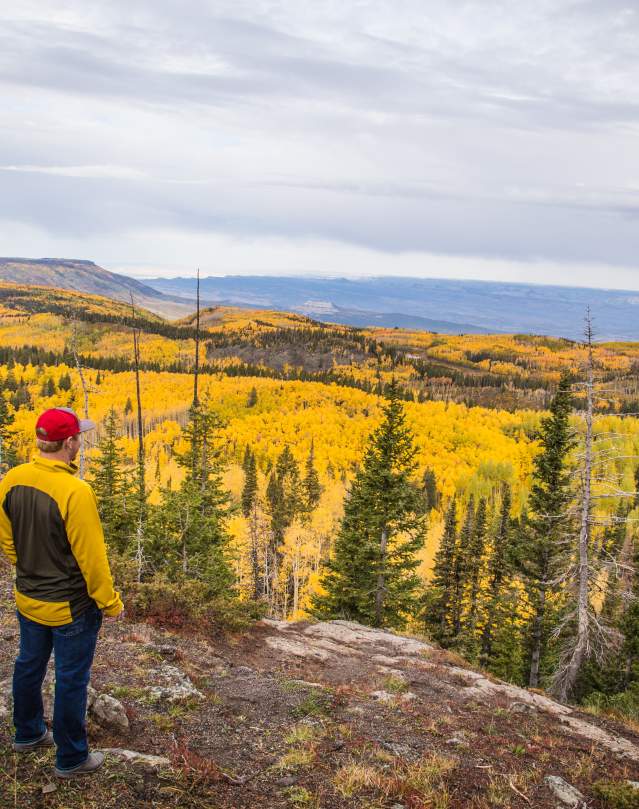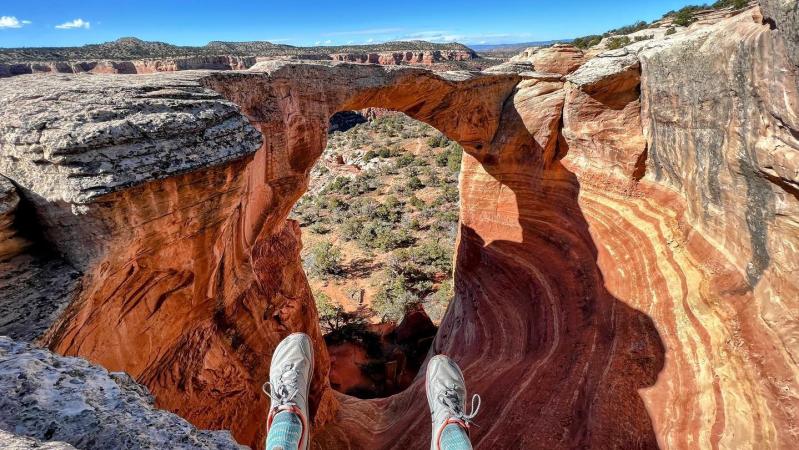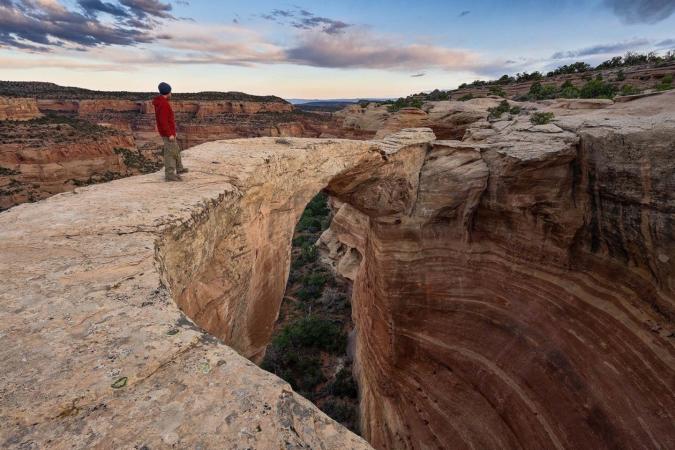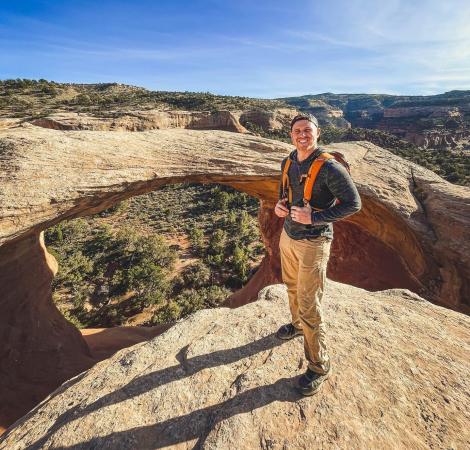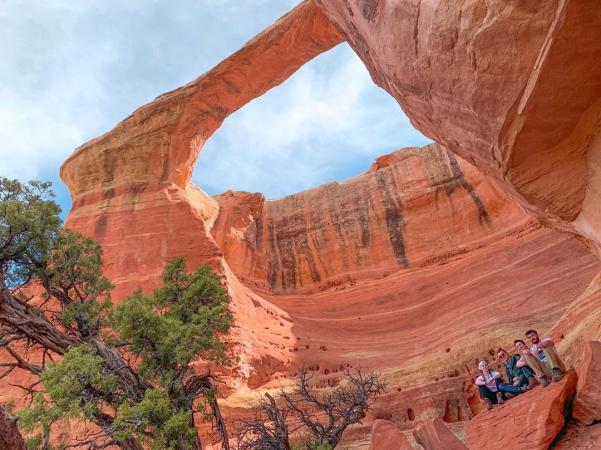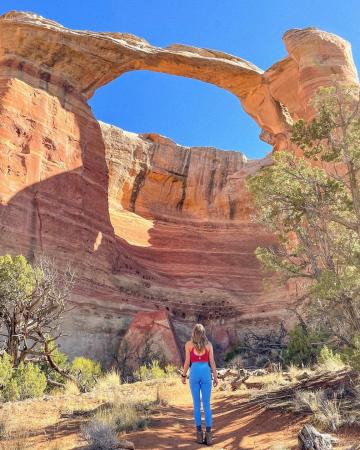Grand Junction is famous for the one and only, Nature's Trifecta, which is a combination of three contrasting and unique geographical landscapes that can't be found anywhere else in the world! They include Colorado National Monument, known as the mini Grand Canyon; the Grand Mesa, the largest flat-top mountain in the world with over 300 lakes; and Rattlesnake Arches, the second-most natural arches in the world.
Designated as the second-largest concentration of natural arches outside of Arches National Park, Rattlesnake Arches completes the trio of natural wonders known as Nature's Trifecta.
Rattlesnake Arches is the second-largest concentration of natural arches in the world. Containing over 35 arches all within a mile of each other and no crowds, take the trail less traveled and explore the arches today. When planning to visit Rattlesnake Arches, it is important to note that there are two possible routes to consider:
1) The first option is a strenuous 15.5-mile roundtrip hike called Pollock Bench Trailhead via Fruita. This route is open year-round, but be sure to plan accordingly if you decide to hike it.
2) The second option is a 13-mile drive that requires a 4-wheel drive vehicle or OHV called Upper Trailhead via Glade Park. This route consists of two different access roads (Upper Access Road and Lower Access Road). The access road you use will depend on the time of the year you plan to visit. The Upper Access Road is open from April 15 to August 15 and the Lower Access Road is open from August 15 to February 15. It is important to note that both roads are closed from February 15 - April 15.
It takes effort to reach the Rattlesnake Canyon Arches, but the reward of breathtaking scenery and solitude through canyons and across scrubby mesas is well worth the challenge. You can learn more about the two routes below or click here for detailed directions on how to find the amazing Rattlesnake Arches.
The Rattlesnake Canyon Arches
The Rattlesnake Canyon Arches were formed in a layer of Entrada sandstone and are scattered along one mile of the Rattlesnake Canyon’s upper rim. The smooth, salmon-colored sandstone was deposited more than 175 million years ago in the form of sand dunes on an ancient coastline. As the inland sea disappeared, erosion started sculpting contoured alcoves. Wind-blown grit, frost wedging, and runoff thinned out the alcoves causing the artistic-looking holes. Trickling water later enlarged the holes, leaving today’s magnificent parade of arches.
In addition to its unique geology, the Rattlesnake Canyon area also features a high-desert ecosystem scattered with piñon pines, junipers, sagebrush, cacti, and yuccas. Hikers often spot wildlife, including mule deer, desert bighorn sheep, grey foxes, cottontail rabbits, and lizards. Don't forget to look up to view turkey vultures, golden eagles, and hawks flying high above the arches. To help you plan ahead for your visit to the Rattlesnake Arches, read below and choose which route you prefer - they are very different options.
Hiking from Pollock Bench Trailhead via Fruita
If you’re looking for a longer hike or just want to avoid the 4x4 route, choose Pollock Bench Trailhead. This trailhead is easily accessible from the mild dirt road running along the Colorado River. From the Pollock Bench Trailhead, hike for six miles, at which point you arrive at the Rattlesnake Arches Trailhead. The strenuous hike threads up rock-walled canyons, scrambles over sandy slabs, and skirts across eroded hoodoos and spires, before ultimately leading you to the same jaw-dropping scenery as the upper trailhead. Plan on a full-day adventure and pack plenty of water - at least two liters per hiker. Even though this hike is exceedingly beautiful, it’s not a dog-friendly trail, especially in the summer. With almost no shade, steep ledges, and rocks that can burn the pads of their feet, it’s best to leave your furry friends behind.
If you are coming from the Pollock Bench Trailhead, continuing on the Rattlesnake Arches Trail will lead you below the arches. If you want to experience one of the arches from above, take a left at the Rattlesnake Arches Trailhead. After turning left, continue on the trail for 0.2 miles until reaching a signpost. Take the "First Arch" trail (as seen on the signpost) for an overlook above Cedar Tree Arch. This is a 0.8-mile roundtrip hike from the signpost.
Adventure Driving to the Upper Trailhead via Glade Park
The 13-mile drive on Black Ridge Access Road, west of Colorado National Monument, takes you to the Upper Access Road and Lower Access Road. Upper Access Road is open from April 15 to August 15 and Lower Access Road is open from August 15 to February 15. These roads are impassable in a vehicle when wet, so plan accordingly to make sure you don’t visit after heavy rain or snow. Both roads converge at the Lower Mee Canyon Trailhead. At this point, if you do not have a high-clearance vehicle you can park and either hike or mountain bike the last two miles to the Upper Trailhead. A high-clearance vehicle with four-wheel drive or an off-road vehicle is required for the last two miles in order to navigate the rocky terrain. When you arrive at the Upper Trailhead, there is a small parking area. From the trailhead, hike 0.5 miles to a vertical signpost that is labeled with "First Arch." At this point, you have the option to turn left to view Cedar Tree Arch from the top, which is a 0.8-mile roundtrip hike from the signpost. Or you can continue straight to Rattlesnake Arches Trailhead.
Exploring the Arches
Both routes (Pollock Bench Trailhead via Fruita & Upper Trailhead via Glade Park) lead you to the Rattlesnake Arches Trailhead. The Rattlesnake Arches Trail is a 4.0-mile out-and-back footpath along a wooded area below the arches.
Cedar Tree Arch, also called Rainbow Arch, is the longest arch in the group, with a span of 76 feet and a vertical opening of 43 feet. Centennial Arch, also dubbed East Rim Arch or Rattlesnake Arch, is the site’s most iconic archway with a thin 40-foot span above a 120-foot-high window. Many of the other arches are smaller windows stamped through roofed alcoves and remain unnamed.
Desert Hiking Safety Tips
The Rattlesnake Canyon Arches and the surrounding McInnis Canyons National Conservation Area, despite being located only 20 miles from Grand Junction, are dissected by deep canyons and lorded over by towering cliffs and buttes. The best seasons to visit are spring and fall when the temperatures are moderate. Summer days can be hot, so plan your hike for early morning or evening. It is recommended to use an app like COTREX or Hiking Project to track your real-time location. Stay hydrated and carry ample amounts of water, sports drinks, and snacks. Be sure to apply sunscreen and wear a hat and protective clothing on sunny days to avoid sunburn. As always, Leave No Trace, and be a good steward to your public lands.
For experienced and adventurous hikers, this trip is not to be missed. While it’s only a short drive from Grand Junction's amenities, you get the feeling that you’re alone with nature, while taking in incredible natural structures millions of years in the making.

